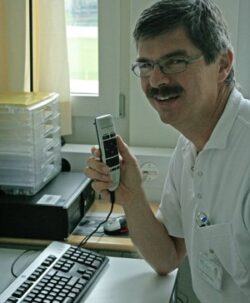Case study – Swiss Paraplegic Centre
Patients thrilled with rapid results
The Swiss Paraplegic Centre is setting new standards for digital dictation in the hospital sector
The Swiss Paraplegic Foundation was established in 1975 and, together with its six subsidiaries and two partner organisations, delivers exceptional work to meet the needs of people with spinal paralysis. The foundation employs over 1,400 people and provides comprehensive services for people with paraplegia, covering scenes of accidents, medical treatment, rehabilitation and lifelong support and advice.
The Paraplegic Centre in Nottwil forms one part of the foundation – a private, nationally recognised specialist clinic offering primary care and holistic rehabilitation to people with spinal paralysis. Dr. André Ljutow, senior physician of the department of pain medicine, was one of the people primarily responsible for initiating and developing the digital dictation solution at the Paraplegic Centre. “When I started working at the Paraplegic Centre in 2004, we were already aware of the importance of mapping documentation processes electronically. Particularly in my area of pain medicine, there are a lot of sub-areas, each with their own requirements surrounding documentation“, explains Dr. André Ljutow. With the introduction of an electronic file in the hospital information system (HIS) and a digital dictation solution in 2004, the department of pain medicine assumed a pioneering role within the Paraplegic Centre. At the time, dictation was fully integrated into the HIS and brought a great deal of structure and security to the department’s working processes.

Finally in 2012, the entire hospital underwent conversion to digital dictation. At the same time, the department of pain medicine chose to go one step further and also incorporated the use of speech recognition software in working processes. The hospital currently has 180 people using the digital dictation solution. The mobile dictation device Philips Pocket Memo and dictation microphone Philips SpeechMike are used as input devices for stationary dictation at PCs. “When introducing digital dictation into daily working practice, it is important to consider that members of staff use different approaches when working at their most efficient. Some opt for traditional process and just dictate; voice files are not converted to text until they reach the secretarial office. There are also users who use speech recognition. Some employees have speech recognition rates of 95%. When working on major projects we have to cater for these differences in ways of working and create appropriate processes”, explains Dr. Ljutow.
“Work is more effective and productive because everyone can focus on their key competencies”
Dr. André Ljutow, senior physician of the department of pain medicine
The workflow
Integration into the hospital information system varies between departments. Dr. Ljutow gives us an insight into his department. The department of pain medicine has its own electronic file in the hospital information system. This in turn is divided into eleven sub-areas. These sub-areas all have various forms which can be filled in using the digital dictation solution.
Dictation can be started directly in the form by pressing a button. The dictation software Winscribe then opens in the background and dictations can be made in the template. At the same time, Voicepoint Importer ensures that dictation files are allocated properly and that audio files are transferred correctly in the system. Labelling also takes place to identify which patient the file relates to, which form, which field, and much more. On the basis of this form, the necessary documents can be created automatically by the secretarial office. Doctors of the department of pain management who prefer to use speech recognition software as an extension to the digital dictation solution, correct their texts themselves. Secretarial staff then create the final text documents. Other doctors who prefer to do without speech recognition dictate their recordings and secretarial staff transcribe the audio files manually. “I leave it up to the doctors themselves to decide how to use digital dictation to their advantage. Some doctors enjoy dictating so much that they use it for creating e-mails, PowerPoint presentations and other documents” says Dr. Ljutow.
The changeover
Philips input devices were used when introducing digital dictation to the whole clinic. “The changeover to our new devices ran smoothly with no problems whatsoever. Integration of the Philips devices was also a complete success. Special attention was made to ensure that every doctor using speech recognition is provided with a Philips SpeechMike since this provides the best speech recognition results with the software used – Dragon Medical Practice Edition”, explains Daniel Dullnig, Project Manager at Voicepoint AG, a certified sales partner of Philips dictation solutions in Switzerland. “Personally speaking, I hardly noticed the transition to our new dictation devices. The device itself is very ergonomically designed and very easy to use. The combination with speech recognition gave a real “wow effect” as it took our document creation process to a new level. I’m very happy with our solution”, says Dr. Ljutow with great enthusiasm.
The main advantages of the solution
“One major change since introducing fully-integrated digital dictation is that print-outs and paper consumption have drastically reduced. No records have to be carried around or filed. Electronic processing is also less prone to error; data can be retrieved quickly and processed safely. Our patients are obviously thrilled given that the time between examinations and results has been shortened significantly. Work is more effective and productive because everyone can focus on their key competencies”, explains Dr. Ljutow. “The Swiss Paraplegic Centre has a promising and stable dictation solution with plenty of scope for ongoing development. It is fully integrated and, when used with speech recognition, is taken to a whole new level. Facilities such as these definitely set new standards in the medical sector. Thanks to close cooperation between customers, sales partners and manufacturers, we have successfully created an outstanding solution”, adds Reto Heusser, Managing Partner at Voicepoint AG.